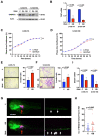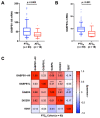Downregulation and Hypermethylation of GABPB1 Is Associated with Aggressive Thyroid Cancer Features
- PMID: 35326537
- PMCID: PMC8946831
- DOI: 10.3390/cancers14061385
Downregulation and Hypermethylation of GABPB1 Is Associated with Aggressive Thyroid Cancer Features
Abstract
Promoter mutations of the telomerase reverse transcriptase (TERT) gene occur frequently in thyroid carcinoma (TC), including papillary (PTC) and anaplastic subtypes (ATC). Given that the ETS family transcription factors GABPA and GABPB1 activate the mutant TERT promoter and induce TERT expression for telomerase activation, GABPB1 has been proposed as a cancer therapeutic target to inhibit telomerase. Here, we sought to determine the role of GABPB1 in TC pathogenesis. In TC-derived cells carrying the mutated TERT promoter, GABPB1 knockdown led to diminished TERT expression but significantly increased invasive potentials in vitro and metastatic potential in a xenograft zebrafish model and altered expression of markers for epithelial-to-mesenchymal transition. GABPB1 expression was downregulated in aggressive TCs. Low GABPB1 expression correlated with its promoter hypermethylation, which in turn was also associated with shorter disease-free survival. Consistently, DNA methylation inhibitors enhanced GABPB1 expression, as observed upon reduced promoter methylation. Our results suggest that GABPB1 is required for TERT expression and telomerase activation, but itself serves as a tumor suppressor to inhibit TC progression. Furthermore, aberrant DNA methylation leads to GABPB1 silencing, thereby promoting TC aggressiveness. Thus, caution is needed if targeting GABPB1 for cancer therapy is considered.
Keywords: DNA methylation; GABPA; GABPB1; TERT; telomerase; thyroid carcinoma.
Conflict of interest statement
The authors declare no conflict of interest.
Figures




Similar articles
-
Thyroid carcinoma-featured telomerase activation and telomere maintenance: Biology and translational/clinical significance.Clin Transl Med. 2022 Nov;12(11):e1111. doi: 10.1002/ctm2.1111. Clin Transl Med. 2022. PMID: 36394204 Free PMC article. Review.
-
GABPA is a master regulator of luminal identity and restrains aggressive diseases in bladder cancer.Cell Death Differ. 2020 Jun;27(6):1862-1877. doi: 10.1038/s41418-019-0466-7. Epub 2019 Dec 4. Cell Death Differ. 2020. PMID: 31802036 Free PMC article.
-
GABPA inhibits invasion/metastasis in papillary thyroid carcinoma by regulating DICER1 expression.Oncogene. 2019 Feb;38(7):965-979. doi: 10.1038/s41388-018-0483-x. Epub 2018 Sep 4. Oncogene. 2019. PMID: 30181547
-
TERT promoter mutations and GABP transcription factors in carcinogenesis: More foes than friends.Cancer Lett. 2020 Nov 28;493:1-9. doi: 10.1016/j.canlet.2020.07.003. Epub 2020 Aug 6. Cancer Lett. 2020. PMID: 32768523 Review.
-
Telomerase reverse transcriptase promoter mutations in thyroid carcinomas: implications in precision oncology-a narrative review.Ann Transl Med. 2020 Oct;8(19):1244. doi: 10.21037/atm-20-5024. Ann Transl Med. 2020. PMID: 33178776 Free PMC article. Review.
Cited by
-
BRAF-induced EHF Expression Affects TERT in Aggressive Papillary Thyroid Cancer.J Clin Endocrinol Metab. 2025 Feb 18;110(3):693-705. doi: 10.1210/clinem/dgae589. J Clin Endocrinol Metab. 2025. PMID: 39183149 Free PMC article.
-
HOMER3 promotes non-small cell lung cancer growth and metastasis primarily through GABPB1-mediated mitochondrial metabolism.Cell Death Dis. 2023 Dec 11;14(12):814. doi: 10.1038/s41419-023-06335-5. Cell Death Dis. 2023. PMID: 38081871 Free PMC article.
-
GABPA-activated TGFBR2 transcription inhibits aggressiveness but is epigenetically erased by oncometabolites in renal cell carcinoma.J Exp Clin Cancer Res. 2022 May 12;41(1):173. doi: 10.1186/s13046-022-02382-6. J Exp Clin Cancer Res. 2022. PMID: 35549739 Free PMC article.
-
The Relevance of Telomerase and Telomere-Associated Proteins in B-Acute Lymphoblastic Leukemia.Genes (Basel). 2023 Mar 10;14(3):691. doi: 10.3390/genes14030691. Genes (Basel). 2023. PMID: 36980962 Free PMC article. Review.
-
Thyroid carcinoma-featured telomerase activation and telomere maintenance: Biology and translational/clinical significance.Clin Transl Med. 2022 Nov;12(11):e1111. doi: 10.1002/ctm2.1111. Clin Transl Med. 2022. PMID: 36394204 Free PMC article. Review.
References
Grants and funding
LinkOut - more resources
Full Text Sources
Molecular Biology Databases
Research Materials

